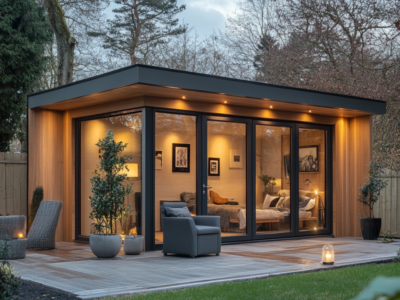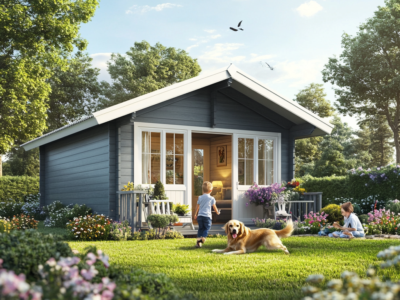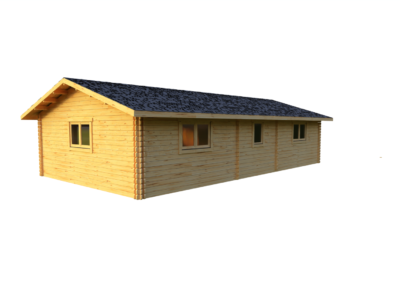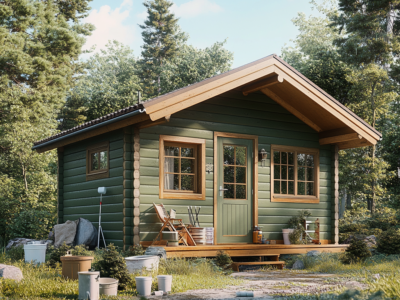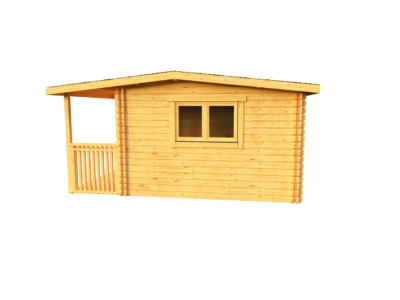Work at home has become an increasingly popular trend, so if you are considering creating a garden office it is vitally important that you ensure it maximizes natural lighting within the space.
Bi-fold or sliding doors allow sunlight to fill a room, but may take away wall space that could otherwise be used for shelving and storage purposes. A skylight or roof light provides another viable option and increases natural lighting in any given space.
Positioning of Trees
Trees are essential elements in our gardens, creating spaces designed for dining, entertaining, playing and working in response to sunlight and shadow. Their placement must strike an equilibrium between aesthetics and their underlying botanical requirements – thoughtful positioning will ensure our wooden sentinels continue to co-create garden experiences for years to come.
As with other features, it’s essential to take into account how tree positioning will influence your garden office and surrounding landscape. Your type of work will dictate the amount of natural light required; ensure your office provides enough without becoming overburdened with sunlight.
Opt for windows facing south, east, and west in your garden room in order to optimize its exposure to natural sunlight throughout the day – this way your office will benefit from a broad spectrum of illumination suitable for work that can be completed both electronically and manually.
Make time to observe and sketch how shade moves across a garden throughout the year, and use that information when placing new plantings to ensure their canopies don’t eventually impede paths or cover seating areas. This will enable you to choose where new plants go more accurately.
Consider where to place specimen trees for maximum effect. Not only can they shield the garden office from view from within your home, but they can also act as focal points when sitting outside enjoying coffee or wine.
If you plan on using your garden room as an outdoor studio, the placement of trees becomes even more crucial. A successful design should aim for clear lines of sight from the entrance of your garden room towards both your house and a wider landscape beyond – something which encourages productivity whilst enjoying nature at its fullest! This will encourage you to leave behind your desk and enjoy nature while remaining productive!
Window Positioning
Your garden office should be designed to take advantage of natural lighting throughout the day, minimizing energy use and protecting your eyes from screen glare. Furthermore, it should be well insulated so it can be utilized throughout all four seasons.
Your choice of windows for your garden office can have a dramatic impact on both its level and quality of light. A full-length floor-to-ceiling window, for instance, will fill your workspace with sunlight – making the room appear larger while creating a connection with nature. If a full window is beyond your budget or too expensive to consider, try adding smaller ones on various walls instead. These may be top hung rectangular windows or something more decorative like porthole windows (sometimes known as bull’s eye windows) which sit gable ends of roofs gable ends gable end roof.
Add skylights or roof windows to your garden office to increase natural lighting levels and maximize natural illumination from above, particularly useful if lighting needs arise during early morning or late afternoon when sunlight is more diffuse. This will let non-glary natural light fill the office from above and is especially beneficial when light is required during these times of the day when sun rays may be weaker.
One way of creating light and adding to the aesthetics of a space is with glazed ceilings, which will let in plenty of illumination while adding visual interest to a room. You have options here, too – partially or fully glazed roofs depending on personal taste are both popular options; garden rooms that double up as home offices often include them.
Alongside overhead lighting, it is also important to include both task and accent lighting in the mix. Task lighting like desk lamps will help reduce glare on screens and make focusing easier while accent lighting can highlight particular aspects of a room such as artwork or architectural features.
Lighting Options
Escritórios de jardim that double as home office spaces benefit from having both task and ambient lighting to help ease eye strain while providing adequate illumination for working. Positioning desk lamps with soft bulbs around your workspace provides stylish task lighting; LED strip lights installed along baseboards offer adjustable mood lighting. Floor or wall-mounted lamps with warm dim bulbs create a cozy reading corner atmosphere and help improve focus.
Shape and location play an essential part in how well garden rooms allow natural light into their spaces. Long, narrow windows tend to let in more sunshine than larger casement style windows which limit how much sun enters a space; to maximize sunlight entering through all three sides, ideal buildings should feature windows on all three sides for optimal lighting conditions.
Positioning trees and plants strategically can significantly influence how much natural light enters a garden office, beyond windows alone. Placing your office near deciduous trees may provide shade in summer while letting light flood through when their leaves have dropped during wintertime.
Glazed roofs are another great way to bring in more natural light, and are frequently featured as part of garden room designs that serve as studios or home offices.
Natural sunlight is essential to our overall health and wellbeing, helping regulate circadian rhythms, increase energy levels and boost our mood.
Finding the optimal lighting levels for your garden office can have a dramatic effect on how productive you are, so don’t underestimate its significance. A little time spent laying out your new workspace could allow for greater output as well as providing you with a happier, less hectic lifestyle.
Garden room suppliers should be able to assist with this task. They understand the significance of good lighting for garden offices, and can advise how you can best utilize your available space. In addition, they may even offer features like desk lamps and LED strip lights as additional options for your office building layout.
Plantas
Addition of plants to a garden office can be an excellent way to increase productivity, enhance air quality and create an uplifting ambiance. Peace lilies and philodendrons make excellent additions for common areas, as they thrive under indirect lighting while larger ZZ plants and ferns add some decoration without needing constant sun exposure.
Relaxation breaks are key to staying productive, so make sure that your garden office design includes a space where you can recharge. From beanbag corners and comfortable sofas, you’ll find plenty of ways to unwind before returning to your work. Regular breaks from work will help increase concentration for longer and fuel creativity – something worth including in any good office design plan.
To maximize natural lighting in your garden room, try designing your office with windows on all three sides: south, east, and west. This will enable you to take full advantage of both morning sunlight and afternoon sun during your workday.
Downlights should also be included in your garden office design to optimize available lighting, such as by placing them above your desk to reduce glare from computer screens and help focus. Low energy lighting solutions like LED bulbs may also prove effective.
Add decorative touches to your garden office, such as a feature wall or shelving units. Personalised decor like artwork and motivational quotes can add character and encourage productive work sessions.
Reliable internet connectivity is key to remote working, so when creating your garden office design it’s essential that you consider where your router should be placed. For larger gardens you may wish to invest in signal boosters to ensure seamless connectivity throughout. These useful devices are easy and affordable enough for installation; their benefits alone make the investment worth your while!

